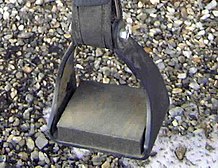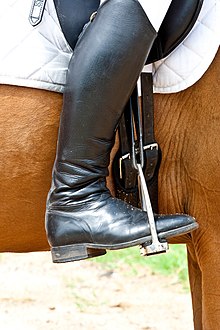
Back Лъэрыгъ ADY Stiebeuel Afrikaans እርካብ Amharic ركاب (فروسية) Arabic Estribu AST Üzəngi Azerbaijani Өҙәңге Bashkir Стрэмя Byelorussian Стреме Bulgarian Stleug Breton


A stirrup is a light frame or ring that holds the foot of a rider,[1] attached to the saddle by a strap, often called a stirrup leather. Stirrups are usually paired and are used to aid in mounting and as a support while using a riding animal (usually a horse or other equine, such as a mule).[2] They greatly increase the rider's ability to stay in the saddle and control the mount, increasing the animal's usefulness to humans in areas such as communication, transportation, and warfare.
In antiquity, the earliest foot supports consisted of riders placing their feet under a girth or using a simple toe loop appearing in India by the 2nd century BC. Later, a single foot support was used as a mounting aid, and paired stirrups appeared after the invention of the treed saddle. The stirrup was invented in the Chinese Jin dynasty during the 4th century, was in common use throughout China by the 5th century, and was spread across Eurasia to Europe through the nomadic peoples of Central Eurasia by the 7th or 8th century.[3][4]
- ^ Chisholm, Hugh, ed. (1911). . Encyclopædia Britannica. Vol. 25 (11th ed.). Cambridge University Press. pp. 928–929.
- ^ "stirrup". Merriam-Webster. 2009.
- ^ Dien 1986.
- ^ Cite error: The named reference
autogenerated3was invoked but never defined (see the help page).